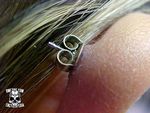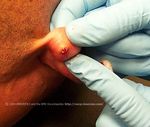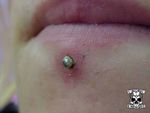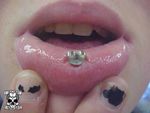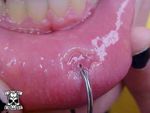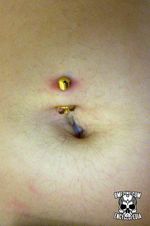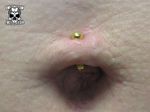Ear Piercing Stud
An ear piercing stud, designed for use with a piercing gun, is usually a sharpened bar with jewelry on one end and a "butterfly" cap that closes over the sharpened end. The jewelry is usually stainless steel in 20 gauge, possibly with a gold plating. Intended for use in earlobes only (although some manufacturers have longer studs for use in cartilage), using this jewelry in other locations tends to turn out badly.
Piercing studs are not suitable body jewelry. Independent of the risks generally associated with piercing guns, piercing studs themselves are simply not acceptable as body jewelry for two primary reasons:
Length - Ear piercing studs are simply not very long. They were designed for ear piercings, and most body piercings pass through more tissue. Thus, using a piercing stud compresses and damages the tissue, making it much harder to heal.
Gauge - Piercing studs are typically 18ga or 16ga, which is too small to safely do most body piercing (and is commonly considered too small for lobe piercings as well).
There are of course a handful of related issues, primarily related to the piercing gun, not the stud. For more information on this read the piercing gun risks entry.
As you can see in the picture above, one of the shortcomings of the design of a butterfly backing is that it collects dead tissue and can be very difficult to clean off. This additionally complicates healing by giving bacteria a place to collect and breed — and cartilage piercings are not a place you want this happening (see: ear collapse)! Because they were designed for use on (small, soft, and forgiving) lobes, ear piercing studs are not very long, and their lack of endowment can prove incapable of satisfying most piercings. Below are two photos of cartilage piercings which had more severe problems due to the piercing studs being used:
And in even less suitable piercings:
In the first two pictures above, you can see a standard ear piercing stud in a labret piercing. The front is irritated and starting to sink into the lip, and on the back you can see an embedded labret problem with the backing cutting and sinking into the lip. When the stud was removed and replaced with a ring the extent of the erosion was evident.
In the piercings above, two navels and a pubic bar, you can see piercing studs being used in a way that can lead to irritation of the piercing, rejection and migration, and undue scarring around the piercing. In all of these cases, the jewelry should be replaced with something suitably sized both in terms of length and gauge to ensure a healthy piercing.
